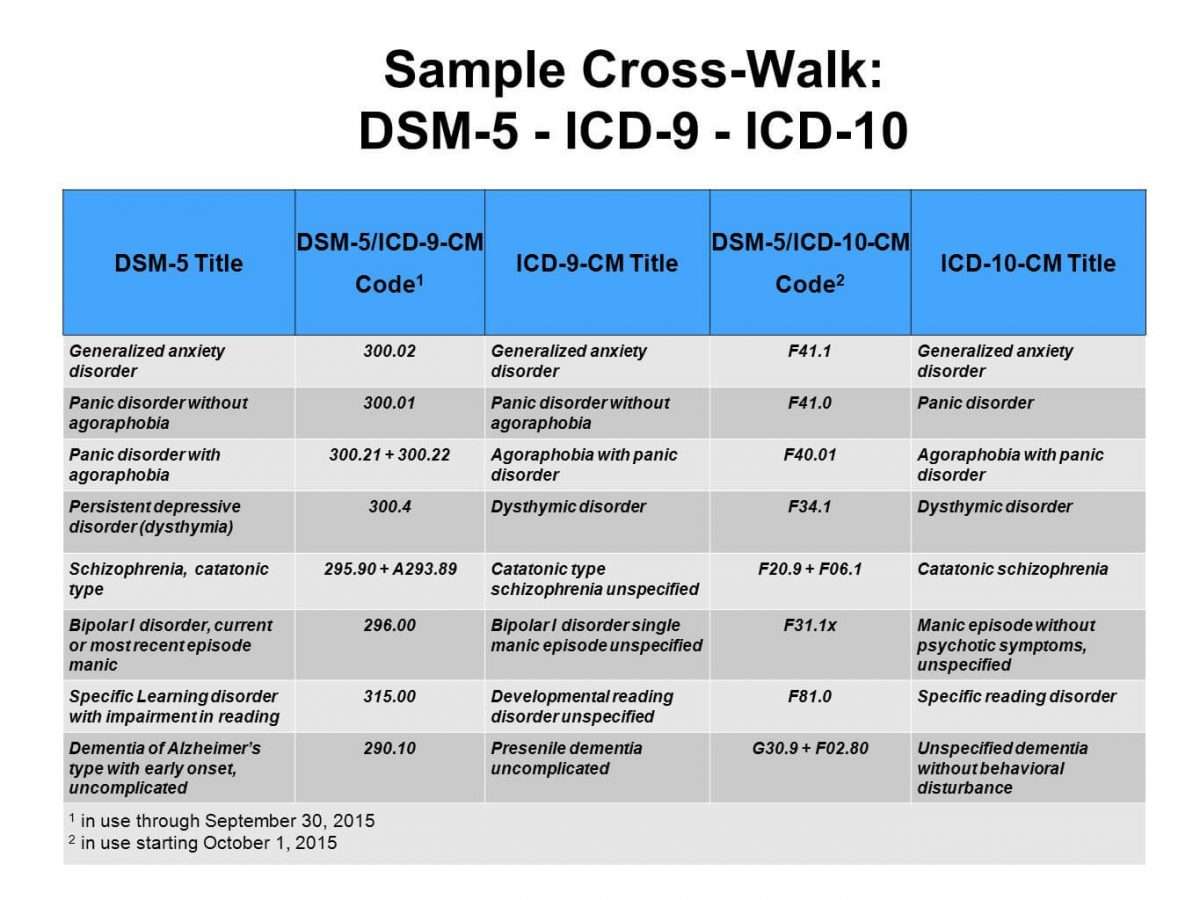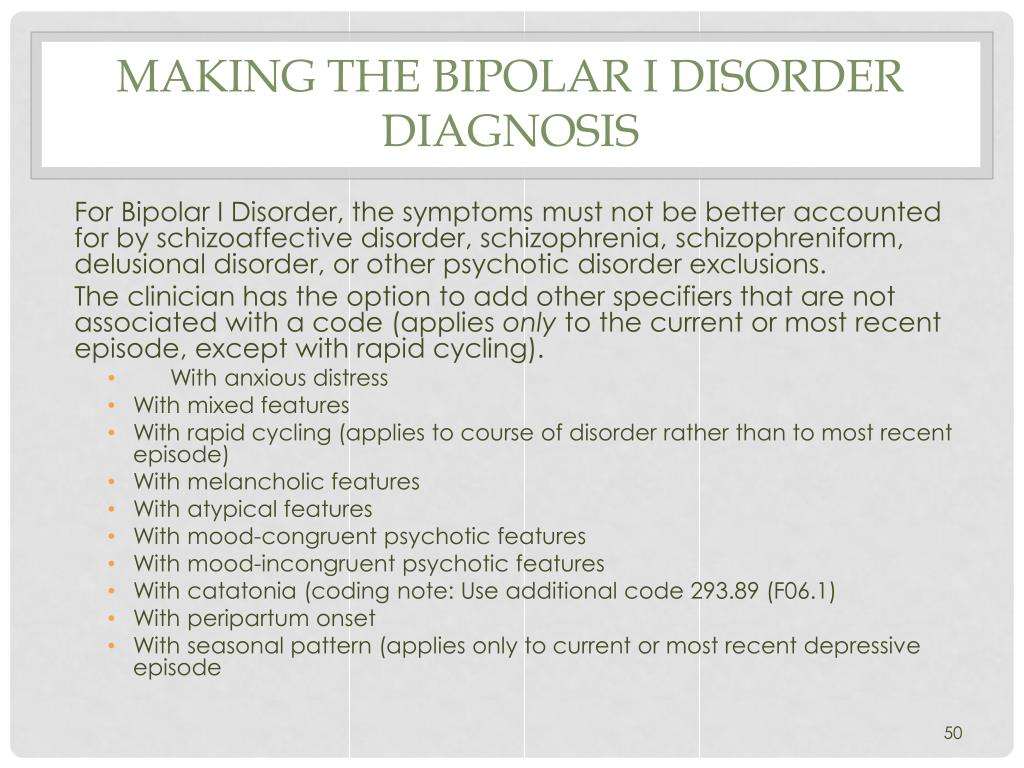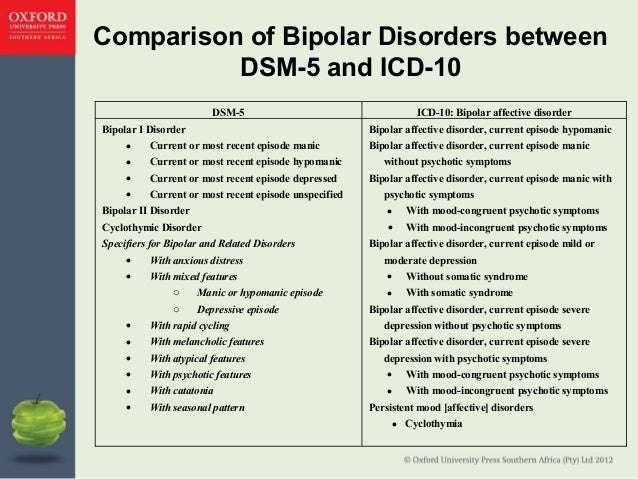Dsm 5 Depression Types
The DSM 5 defines the following types of Depression:
- Disruptive mood dysregulation disorder
- Major depressive disorder
- Persistent depressive disorder ,
- Depressive disorder due to another medical condition
- Unspecified Depressive Disorder
The DSM 5 depression criteria specifies the symptoms, exclusions and time periods for all the subtypes, and to be concise only the main ones are described below.
The key difference between the ICD and DSM 5 Depressive disorders is that the Premenstrual syndrome has not been recognized separately in the ICD 10 , and Substance use induced depression is also not coded under depression and is not a separate category under the substance chapter.
There are several depression tests available online but these are rarely clinical tests and their results should not be relied upon,
Unspecified Vs Specified Bipolar Disorder
As mentioned, the American Psychiatric Association prefers the terms unspecified or specified for bipolar disorder to better reflect the uncertainty of the diagnoses. .
Specified bipolar disorder may be diagnosed when a person displays specific symptoms of bipolar , but the full criteria for those symptoms aren’t met. Unspecified bipolar may be the diagnosis when a person’s symptoms resemble the symptoms of bipolar disorder, but they can’t be labeled as bipolar symptoms for certain.
Zurich Study Sample And Definitions
The Zurich study is an epidemiological study, which followed the probands over a period of 30 years from the ages of 19/20 to 49/50. The interview sample was selected from an initial cohort of 4547 people representative of the canton of Zurich in Switzerland, who were screened in 1978 by the Symptom Checklist 90 when they were 19 years old or 20 years old .
To increase the probability of the development of psychiatric syndromes, a stratified sub-sample of 591 subjects was selected for the longitudinal study. Two-thirds of the sample consisted of high scorers and one-third of a random sample of those with scores below the 85th percentile . The use of stratified samples is not uncommon in epidemiological research . Altogether, seven interview waves were conducted: in 1979, 1981, 1986, 1988, 1993, 1999 and 2008. For the present analysis only data collected from 1986 onwards were used in 1986 an interview section on mania was added to the interview. The initial allocation to the two strata did not change over the studys time span.
The analysis is presented both with the raw figures and with figures after reweighting to offset the stratification . For the reweighting, the analysis was conducted with the SAS procedure PROC SURVEYFREQ.
Read Also: What Should You Do If Your Depressed
Disruptive Mood Dysregulation Disorder
The DSM 5 criteria for Disruptive mood dysregulation disorder is given as follows:
Bipolar Disorder Current Episode Depressed Severe With Psychotic Features

- 2016201720182019202020212022Billable/Specific Code
- F31.5 is a billable/specific ICD-10-CM code that can be used to indicate a diagnosis for reimbursement purposes.
- Short description: Bipolar disord, crnt epsd depress, severe, w psych features
- The 2022 edition of ICD-10-CM F31.5 became effective on October 1, 2021.
- This is the American ICD-10-CM version of F31.5 – other international versions of ICD-10 F31.5 may differ.
- Bipolar disorder, current episode depressed with mood-incongruent psychotic symptoms
- Bipolar disorder, current episode depressed with mood-congruent psychotic symptoms
- Bipolar I disorder, current or most recent episode depressed, with psychotic features
- Applicable To annotations, or
Read Also: Who Do You Go To For Depression
Manic And Hypomanic Episodes In Icd
DSM-5 defines manic episodes and hypomanic episodes slightly more restrictively in that for cases with mood irritability only it requires 4 rather than 3 of the 7 symptoms for a diagnosis ICD-11 does not single out irritability in this way.
Similarly the minimum duration of a hypomanic episode is 4+days in DSM-5 and several days in ICD-11 For the purposes of our analysis several was interpreted as 4+consecutive days.
One further restriction in the definition of a hypomanic episode in DSM-5 relates to changes in functioning. In DSM-5 criterion C: an unequivocal change in functioning uncharacteristic of the person, and criterion D: the disturbance in mood and the change in functioning are observable by others must be met. In ICD-11 this is less categorically expressed as the significant change in the usual range of moods and behaviour would be apparent to people who know the individual well.
Background For Changes From Dsm
Initially when Kraepelin described mania and depression, he identified three core domains mood, cognition and motor activity – without ascribing primacy to any of these three domains . It was only later with the appearance of the DSM that mood was highlighted as the most important domain . The modification of the criterion A in DSM-5, requiring the presence of increased energy or activity for the diagnosis of mania and hypomania and, therefore,
Read Also: Teenage Anxiety And Depression Solutions
What Not Otherwise Specified Means
Bipolar disorder NOS is more of a catch-all category than an actual type of bipolar disorder. Your doctor may use the classification to document symptoms which are consistent with bipolar disorder but fall short of the criteria needed to make a definitive diagnosis.
In general, NOS is most commonly ascribed when a mood disorder is characterized by depression alternating with short episodes of hypomania . Oftentimes, the mood swings are rapid, occurring within days of each other. By and large, children and adolescents are most frequently diagnosed with NOS as they will be least likely to have a previous history of mood dysfunction.
From a psychiatric standpoint, bipolar disorder NOS is taken just as seriously as any other form of mood disorder. It presumes that there is a concern and that it likely will be more definitively diagnosed in the future.
Still, there remains contention in the psychiatric community as to whether bipolar disorder NOS is a valid diagnosis or if it may lead to the premature treatment or over-treatment of an otherwise presumptive illness.
Bipolar 2 Symptoms Of Major Depression
A major depressive episode involves depressive symptoms that are severe enough to cause noticeable difficulty in daily tasks like work, school, and activities, as well as in relationships. An episode of depression consists of five or more of the following symptoms which persist for at least two weeks:
- Depressed moodfeeling sad, empty, hopeless or teary. In children and adolescents, this can manifest as irritability.
- Significant loss of interest or feeling of no pleasure in all or most activities
- Weight loss when not dieting, weight gain, or abnormal increase/decrease in appetite
- Insomnia or oversleeping
- Thinking about, planning, or attempting suicide.
Don’t Miss: Crystal That Helps With Depression
How Is Depression Different From Sadness
What is the difference between depression and sadness? Given that the primary symptom associated with depression is sadness it can be hard to know how to make a distinction between the two psychological states.
But depression is more than just sadness, and not simply by a measure of degree. The difference doesnât lie in the extent to which a person feels down, but rather in a combination of factors relating to the duration of these negative feelings, other symptoms, bodily impact, and the effect upon the individualâs ability to function in daily life.
Sadness is a normal emotion that everyone will experience at some point in his or her life. Be it the loss of a job, the end of a relationship, or the death of a loved one, sadness is usually caused by a specific situation, person, or event. When it comes to depression, however, no such trigger is needed. A person suffering from depression feels sad or hopeless about everything. This person may have every reason in the world to be happy and yet they lose the ability to experience joy or pleasure.
With sadness, you might feel down in the dumps for a day or two, but youâre still able to enjoy simple things like your favorite TV show, food, or spending time with friends. This isnât the case when someone is dealing with depression. Even activities that they once enjoyed are no longer interesting or pleasurable.
Bipolar 1 Vs Bipolar 2
The most prevalent contrast between bipolar 1 and bipolar 2 is complete mania that lasts at least a week compared to hypomania that persists throughout most of the day for at least four days. When a person experiences a manic episode, a qualified psychiatrist might diagnose them with bipolar 1, aka manic depression.
Don’t Miss: What Factors Led To The Great Depression
How Is Bipolar Affective Disorder Defined In The 5th Edition Of The Diagnostic And Statistical Manual Of Mental Disorders
In the 5th edition of the Diagnostic and Statistical Manual of Mental Disorders, , bipolar disorder constitutes a spectrum of mood disorders that includes BPI, BPII, cyclothymia and are thought to be a bridge between schizophrenia spectrum disorders and depressive disorders in terms of the symptomology, family history and genetics.
Bipolar Disorder In The Dsm

Even though childhood bipolar disorder has been well-defined and used for many years, pediatric bipolar disorder is not a new diagnosis in the DSM-5. Instead, a category of depressive disorders has been added called disruptive mood dysregulation disorder . The driver for this was a concern that the diagnosis of pediatric bipolar disorder was being inconsistently and overly applied to different types of childhood irritability.
For bipolar disorder under the DSM-5, there are now seven possible diagnoses:
- Bipolar I Disorder
- Substance/Medication-Induced Bipolar and Related Disorder
- Bipolar and Related Disorder Due to Another Medical Condition
- Other Specified Bipolar and Related Disorder
- Unspecified Bipolar and Related Disorder
Additional changes include:
- Elimination of “Mixed Episode.” Instead, a manic, hypomanic, or depressive episode can be specified as “With Mixed Features,” a specifier with its own definition in the manual.
- The Bipolar II diagnosis in the DSM-IV excluded a history of mixed episodes. This exclusion has been removed, an important change.
- A subtle change is that the word “abnormally” was not included in the DSM-IV Criterion A for a hypomanic episode, while it was in Criterion A for a manic episode. In the DSM-5, this language is present for both episodes. This brings the full criteria for the two distinct types of episodes closer together.
Each type of bipolar disorder has what are called specifiers that further clarify the illness.
Read Also: Do Dogs Get Postpartum Depression
When A Diagnosis Is Suggestive Rather Than Indicative Of Bipolarity
Bipolar disorder not otherwise specified is one of those psychiatric terms that can cause more confusion than clarity, especially to the person being diagnosed. Bipolar disorder NOS is usually diagnosed when a patient shows some symptoms of bipolar disorder but doesn’t necessarily meet all the criteria as outlined in the Diagnostic and Statistical Manual of Mental Disorders.
The term bipolar disorder NOS was used in the fourth edition of the DSM however, the DSM-5 actually uses the terms “unspecified bipolar disorder” or “specified bipolar disorder” to diagnose conditions that were previously called bipolar disorder NOS.
Like schizoaffective disorder, a condition that falls somewhere in between schizophrenia and bipolar disorder, bipolar disorder NOS may suggest you are at risk of eventually developing bipolar disorder.
Attenuated Psychosis Syndrome And Shared Psychotic Disorder
The Psychotic Disorders Work Group considered adding attenuated psychosis syndrome as a new diagnosis to DSM-5, but instead decided to place it in Section III as a condition for further study, after field trial data showed that it was not diagnosed reliably by clinicians. Attenuated psychosis syndrome is meant to describe people who show recent onset of modest, psychotic-like symptoms and clinically relevant distress and disability . In addition, the person who experiences the symptoms must recognize them as unusual and experience sufficient distress or disability to seek clinical evaluation. Despite the clear guidance in the DSM-5 that conditions in Section III are not intended for clinical use, this syndrome is not just in Section III, but is also specifically identified in Other Specified Schizophrenic Spectrum and Other Psychotic Disorder as one of four examples of alternative presentations of a psychotic disorder where it is labeled other psychotic disorder, attenuated psychosis syndrome .
Read Also: Best Natural Herbs For Depression And Anxiety
How To Diagnose Bipolar Disorder: Dsm
Bipolar disorder affects millions of people around the world, and its extreme ups and downs can make living life challenging at times. This article will discuss the DSM-5 bipolar disorder criteria, which is the most up-to-date information on how the condition is diagnosed. Additionally, you will learn how a diagnosis can influence a course of treatment and what methods are effective.
What Is Bipolar Disorder?
Bipolar disorder is characterized by shifts in mood, and those who have it can experience high energy, euphoria, and become overactive. This is known as mania, and it can also include irritability, and some people can become easily agitated in a manic state. Manic episodes also associated with risk-taking behaviors and increased impulsivity
On the other end of the spectrum, people with bipolar disorder can have very low moods, and this is the depressive side of the condition. Just like with major depression, bipolar sufferers who are having a depressive episode can feel down on themselves, have low energy and motivation, and think about death and suicide.
Nonetheless, these mood swings are not typically short and temporary. Instead, these episodes must last at least a week for mania and two weeks for depression for the person to have Bipolar I disorder. This is not only important for diagnosing bipolar disorder, in general, but it can also determine what type a person has, which you will learn more about in the next section.
The Types Of Bipolar Disorder
Ethics Approval And Consent To Participate
The authors assert that all procedures contributing to this work comply with the ethical standards of the relevant national and institutional committees on human experimentation and with the Helsinki Declaration of 1975, as revised in 2008. The project received prior approval from the Ethical Committee of the Zurich University Psychiatric Hospital.
Also Check: Depression In Bed All Day
Dsm 5 Bipolar 2 Criteria
Someone experiencing bipolar 2 hypomania experiences at least four days of elevated mood change, which might include feelings of increased energy, irritability, and expansiveness. Their daily life is clinically impaired by the hypomanic episode, but not as seriously as manic symptoms like delusions and/or hallucinations that could cause a manic person to seek inpatient treatment. According to the Fifth Edition of the Diagnostic and Statistical Manual of Mental Disorders , published by the American Psychiatric Association, someone who has experienced a manic episode cannot be diagnosed with type 2 bipolar disorder.
Bipolar I Disorder Diagnosis Criteria
To be diagnosed with bipolar I disorder, an individual must meet the full criteria of a manic episode, which includes three of the following symptoms:
- Increased talkativeness
- Lack of energy or fatigue
- Loss of interest and pleasure in activities he or she previously enjoyed
- Feelings of restlessness or slowing down
- Feelings of guilt or worthlessness
- Difficulty concentrating or making decisions
- Suicidal thoughts
If you think you may have bipolar II disorder, be sure to tell your doctor about all of your symptoms, including hypomanic symptoms, such as elevated mood. Clinicians sometimes diagnose patients with major depression instead of bipolar II disorder if the patient does not disclose information regarding his or her hypomanic episodes.
Cyclothymic Disorder Criteria
While the diagnosis of bipolar I and bipolar II disorders is somewhat straightforward when it comes to telltale symptoms, the cyclothymic disorder is often more difficult to diagnose. Patients must experience the following symptoms for diagnosis:
Note: The two year time period noted above is for adult patients only. Diagnosis of cyclothymic disorder in children and adolescents requires one year of hypomanic and depressive periods.
Substance-Induced Bipolar Disorder Criteria
Bipolar Disorder Associated With Another Medical Condition Criteria
Bipolar Disorder Not Elsewhere Classified Criteria
Treatment Options For Bipolar Disorder
Psychotherapy, Support Groups, And Psychoeducation
Medications
Recommended Reading: Depression Meds And Weight Loss
Impact Of Bipolar 2 Disorder
People with an untreated bipolar disorder may have serious problems in many features of their lives. The various depressive, hypomanic, or manic episodes may seriously impair functioning. The average age of onset is mid-20s, which is later than type 1 bipolar but earlier than major depressive disorder . People with untreated bipolar 2 may have a lower socioeconomic status due to a lag in occupational recovery after episodes. But early intervention for the disorder can help prevent negative functional consequences.
Treating Bipolar Spectrum Disorders

Early assessment and treatment of bipolar spectrum disorders is crucial, especially considering that both medical and psychiatric comorbidities are common in this patient population. Further, the rate of suicide among individuals diagnosed with bipolar disorder is approximately 10 to 30 times higher than that of the general population.
See our bipolar 1 disorder treatment guidelines for mental health clinicians and new research on how brain patterns tied to reward anticipation may help clinicians differentiate bipolar disorder from schizophrenia.
You May Like: Things To Say To Someone That Is Depressed